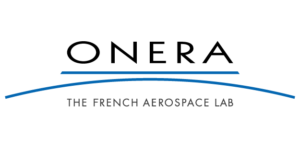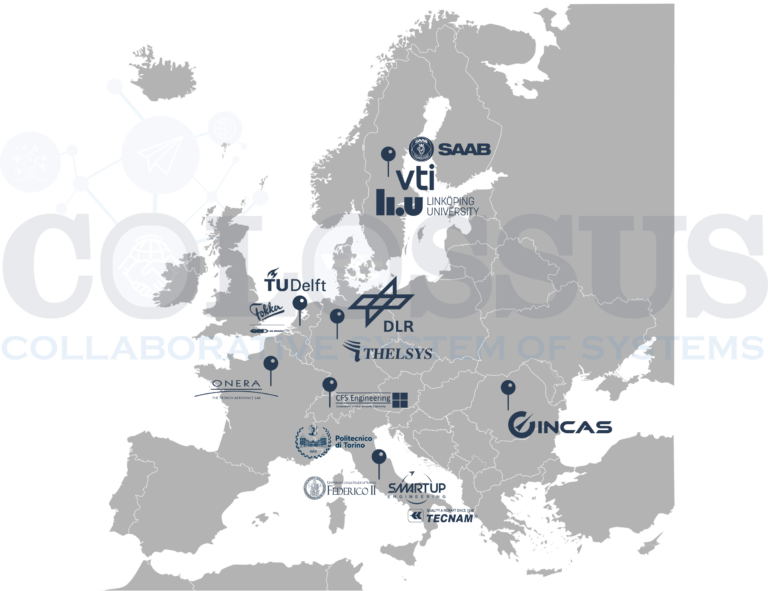PROJECT PARTNERS
Contribution of Each of the Consortium Members

DLR coordinates project and WP3. In WP3, DLR will contribute with its MBSE and MDO expertise and digital technologies developed within the context of the AGILE and AGILE 4.0 projects. DLR will then coordinate with the other WP3 partners the extension of these technologies to address the system-of-systems level. Moreover, DLR will provide support to project partners for the integration of their disciplinary capabilities into the TDC Framework. In WP2, DLR will be responsible of delivering a technology portfolio, collecting different future technologies to be integrated on aeronautical products operating in system-of-systems scenarios. DLR will also provide ABM simulation capabilities at system-of-system level in WP5.

SAAB is the WP2 lead and a strong involvement in WP5 and in WP3 among other. With a strong expertise in complex aircraft product development and a complete aerial firefighting operation, with aircraft, pilots and maintenance organization. SAAB will bring multiple viewpoints and analysis capabilities into the to-be-developed SoS framework, with focus on the stakeholder and ConOps analyses and the linking of WP5 to WP2 via the Interactive Dashboard. SAAB has also a long-lasting history on MBSE and will significantly contribute to the SoS framework development, supporting the ABM work in WP5.

ONERA has a strong involvement in WP3 and in WP5. In WP3, ONERA will lead and contribute to task related to multi-level optimization approaches and IA developments. In addition, ONERA will participate to the digital framework requirements identification. In WP5, ONERA will apply WP3 methods related to IA and optimization to SoS Use Cases. ONERA will also provide support in WP4 system optimization level using RSM. ONERA will contribute in WP6 to the dissemination activities with conference participations and scientific articles.

LIU leads the SoS ABM research and implementation work in WP5. To do so, considerable implementation work is conducted in WP2 on the engineering framework. Optimization and AI-based algorithm work conducted by ONERA will be largely supported by LiU, too. Also, to perform and assess the use cases, work focusing on the stakeholder needs and requirements, the design space exploration and the SoS dashboard (for visual analyses) in WP2 will be assisted by LIU, complemented by minor work on the cost models to support POLITO in their work

UNINA will have a strong involvement in WP4 (seaplane vehicle design) and some minor involvement in other WP. UNINA will deal with powertrain definition and with the design of the configuration, including the assessment performed through a wind-tunnel test campaign in its low-speed wind-tunnel. The design capabilities of the DAF research group will complement very well in WP4 with the industrial experience coming from TECNAM and with the reliable aerodynamic analysis (high-fidelity CFD) that will be performed by CFS and with the support of SmartUp for the CAD and geometrical modelling. The experience of UNINA in direct operating cost estimation will also support WP2 while the previous experience matured in AGILE project will contribute in WP3 and WP5.

POLITO coordinates the task related to LCC and LCA model development and implementation together with the involved partners SmartUp, UNINA, and Fokker. POLITO will support the cost estimation and design activities carried out in WP4 and WP5, providing on-board systems design and estimation of the RAMS characteristics of the systems involved. POLITO will provide feedback on business model defined in WP2 in terms of cost and requirements and support the dissemination activities with congress proceeding and scientific articles. Also, POLITO will exploit the results of the project updating and expanding academic courses and its research activities.

TECNAM will be deeply involved in WP4, giving all the necessary support for the best design of the seaplane vehicle including commonality aspects. TECNAM will define the best structural layout and will contribute to the most reliable weight estimation defining and solving in WP4 all the necessary critical issues dealing with certification. In WP2, TECNAM will give also a strong contribution concerning market needs, operational aspects, direct operating costs and especially production issues. The experience with commuter aircraft clients will be also crucial to support the optimization of the SoS scenarios in WP5, coupling the best aircraft with the best operational scenario.

TUD will participate in WP4 and WP5. TUD will work on the design and optimization of the Seaplane and eVTOL, collaborating with UNINA and TECNAM for the aerodynamic and structural modelling of the vehicle. TUD will also update the design based on the requirement and on the architecture from SmartUp and POLITO, while ONERA will support with optimization process knowledge. In WP5 TUD will cooperate with INCAS and DLR building up on the AGILE framework and adding a path planning for mobility use and implementing system-specific operational concepts.

INCAS leads task 3.5, developing clustering algorithms and anomaly detection methods for product and operational efficiency specific to SoS simulations. Additionally, INCAS will lead task 5.3 and perform a SWOT analysis of the SOTA ABM solutions, emphasising performance, optimisation and run time. Considering the tool analysis and the recommendations from the partners, INCAS will set up the ABM framework. In task 5.4, INCAS will support the simulation implementation with its machine learning and AI expertise.

Thelsys will be mainly involved in WP2 and WP5. In WP2, the company works on identification of all stakeholders of the use cases, the creation of business models and the respective SoS scenarios, and participate in the subsequent assessment of both use cases. In WP5, Thelsys will support the ConOps analysis and the complexity management. Activities in WP4 ensure the smooth interaction between the SoS level (ConOps, requirements, scenarios) and the multidisciplinary design of the air vehicles. In WP1, Thelsys will ensure that COLOSSUS complies with the ethics requirements, and besides taking part in the dissemination & exploitation activities of WP6, Thelsys will actively contribute to the data management plan.

SmartUp will be involved in WP2 where will support the implementation of the dashboard environment to address the main objective of task 2.4. To achieve this task, SmartUp will strongly collaborate with all the other partners of the project to collect all the output data. Moreover, SmartUp will be strongly involved in WP4 supporting UNINA in the model design and for the set-up of the wind-tunnel model- Additionally SmartUp will be involved in WP2 developing LCA and LCC together with the partners of WP4. SmartUp will provide a visual identity of the project and the development of the website strongly interacting with all the other partners.

GKN Fokker will be mainly involved in providing tier 1 supplier industry feedback and requirements for the framework developed (WP3) and the integrated aircraft designed (WP4) and collaborating with the other partners in thse and other WP’s. The main focus on the feedback will be on manufacturing. Furthermore GKN-Fokker will also supply a detailed manufacturing cost model which will be developed to fit the requirements of this project. This model will also be made available to the other partners in the project. Finally GKN-Fokker will also be involved in WP2, WP5 and WP6 providing industry feedback.

CFSE will be involved in WP3 where it will work on the integration of the CFSE tools in the response surface model. CFSE is also involved in WP4 and will perform high fidelity simulations for the different configurations studied in the project and will participate in the rebuilding of the wind-tunnel measurements. CFSE will lead the Dissemination, Communication and Exploitation work package, an activity it also carried out successfully in several other FP6, FP7 and H2020 projects.

VTI will be involved in WP2 and WP5, contributing with their insights from the transportation stakeholder needs for the mobility use case to support the requirement and needs analyses. VTI will furthermore support the SOTA analyses of ABM tools and being actively involved in the definition of the to be developed ABM framework. Finally, the transportation use case results will be reviewed by VTI in WP5.
Extraordinary Experiences
Click edit button to change this text. Lorem ipsum dolor sit amet, consectetur adipiscing elit. Ut elit tellus, luctus nec ullamcorper mattis, pulvinar dapibus leo.
Our Core Values
- Locavit liberioris possedit
- Diremit mundi mare undae
- Spectent tonitrua mutastis







